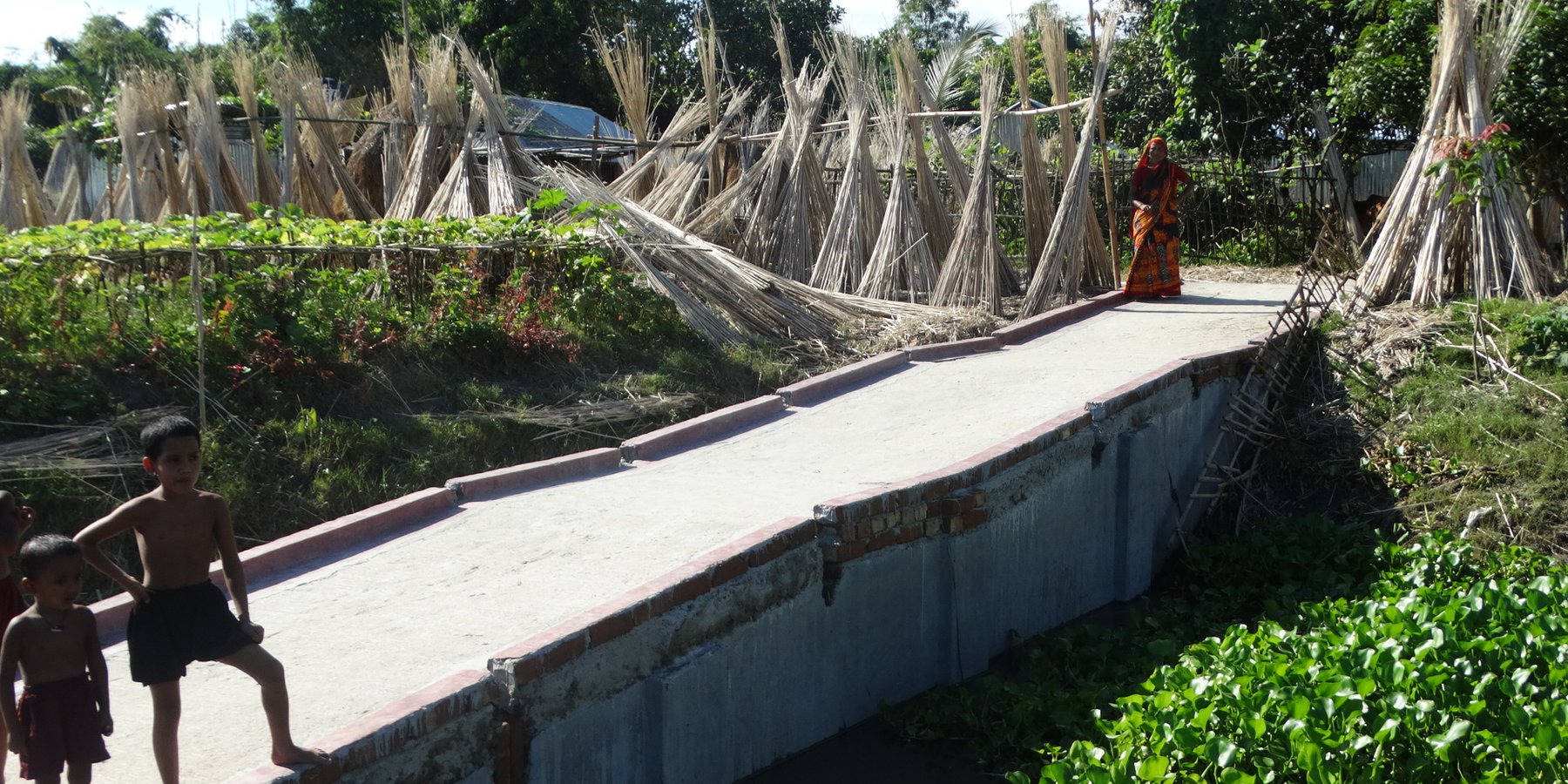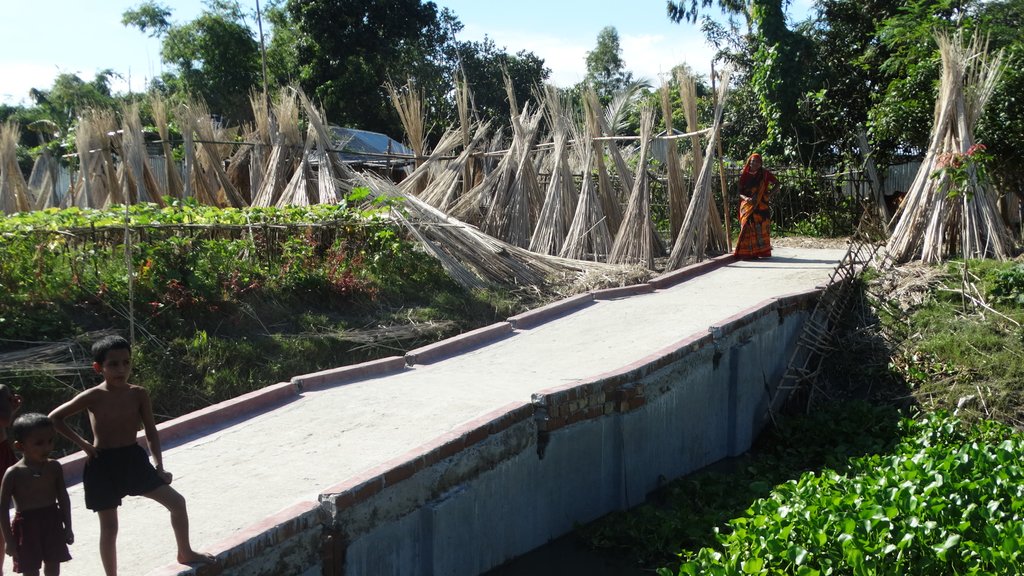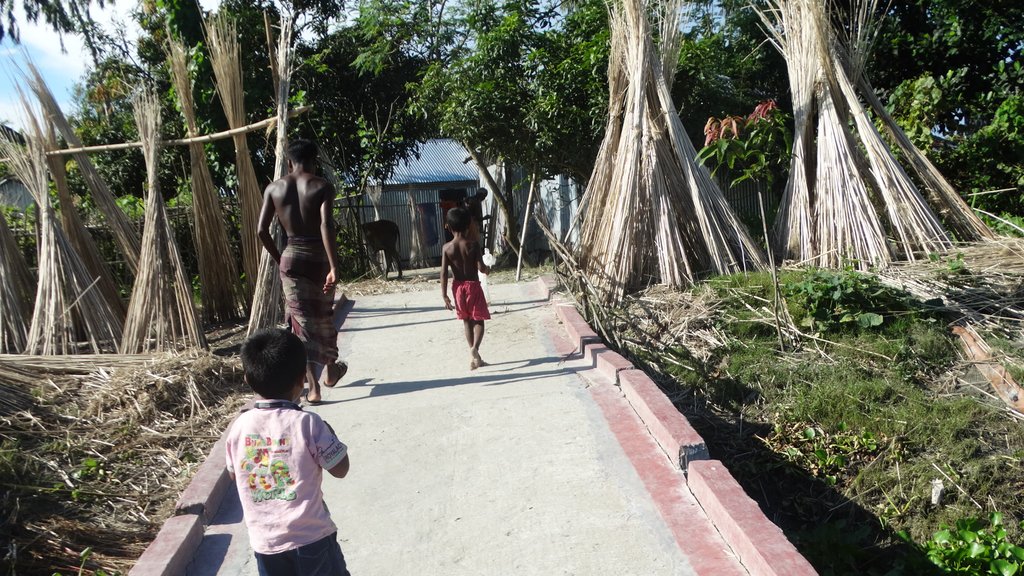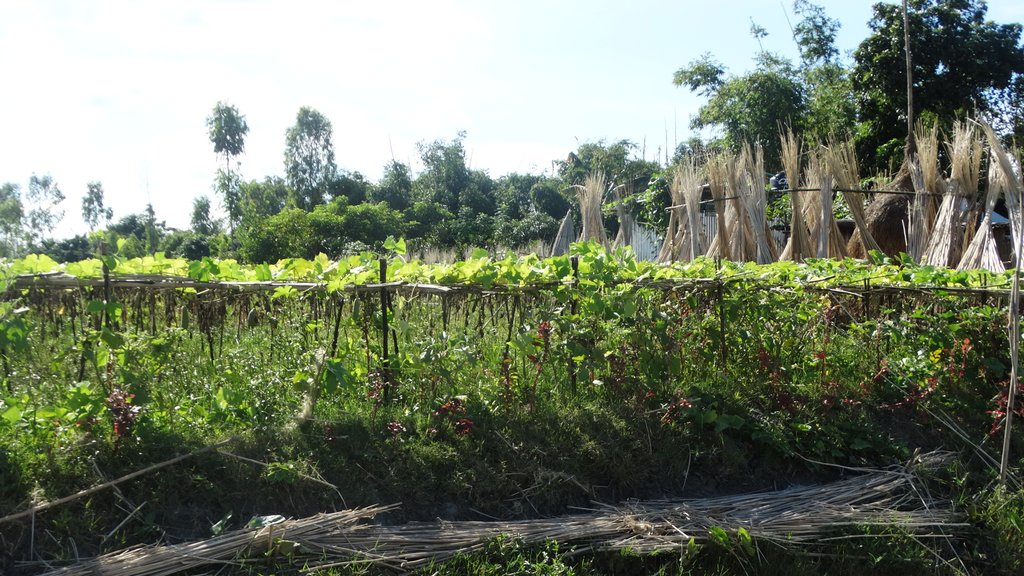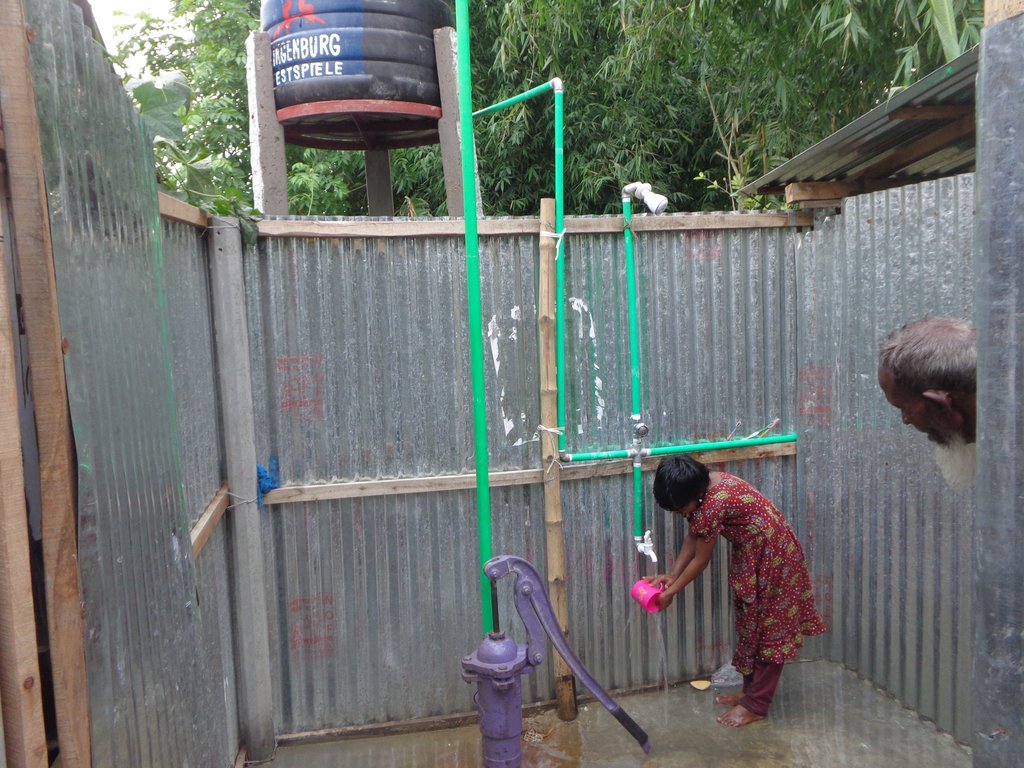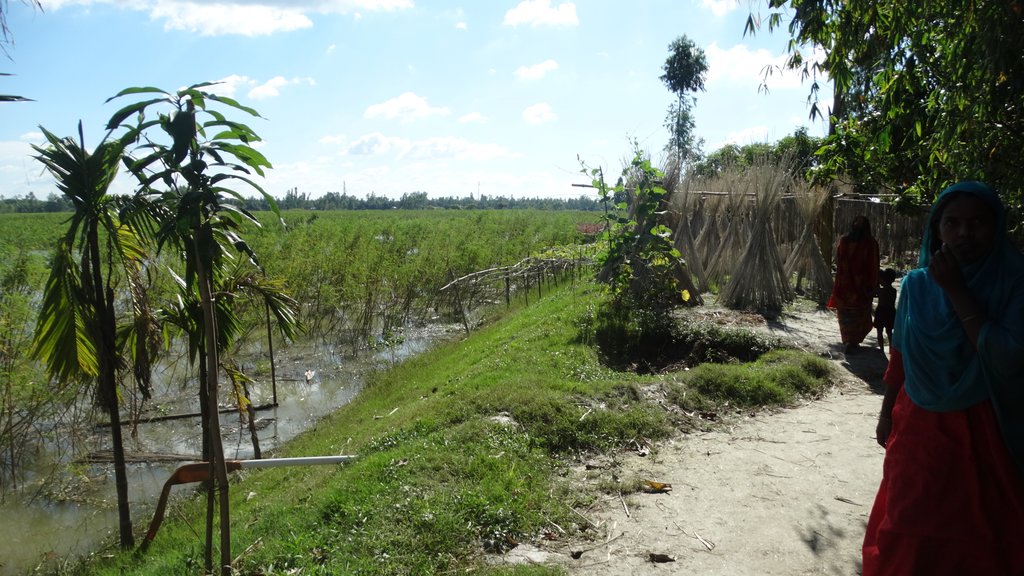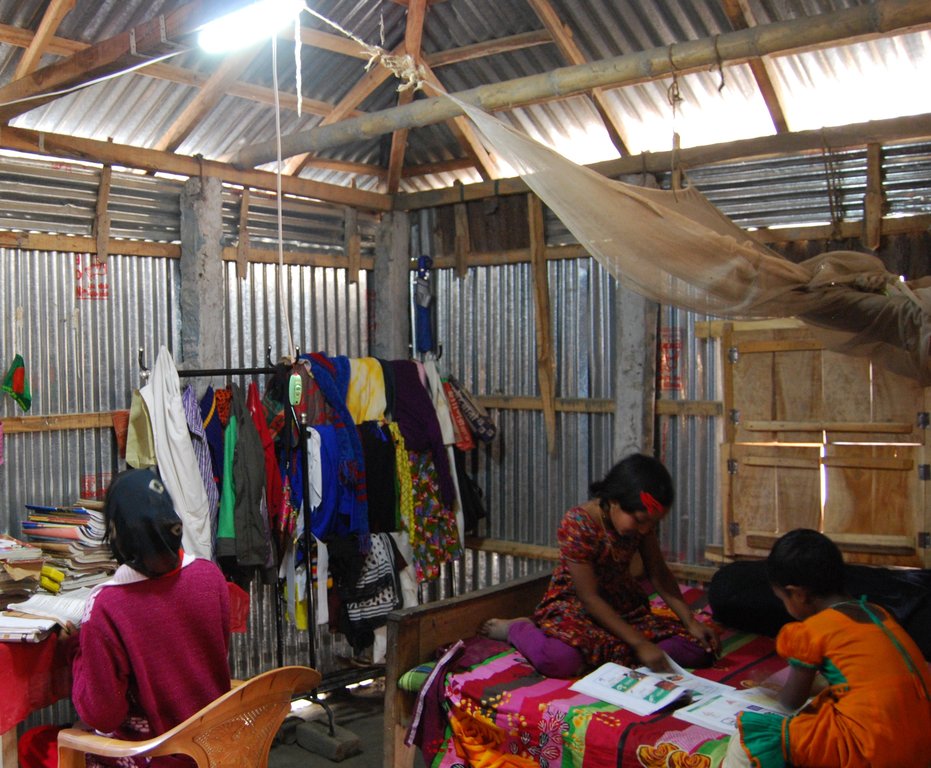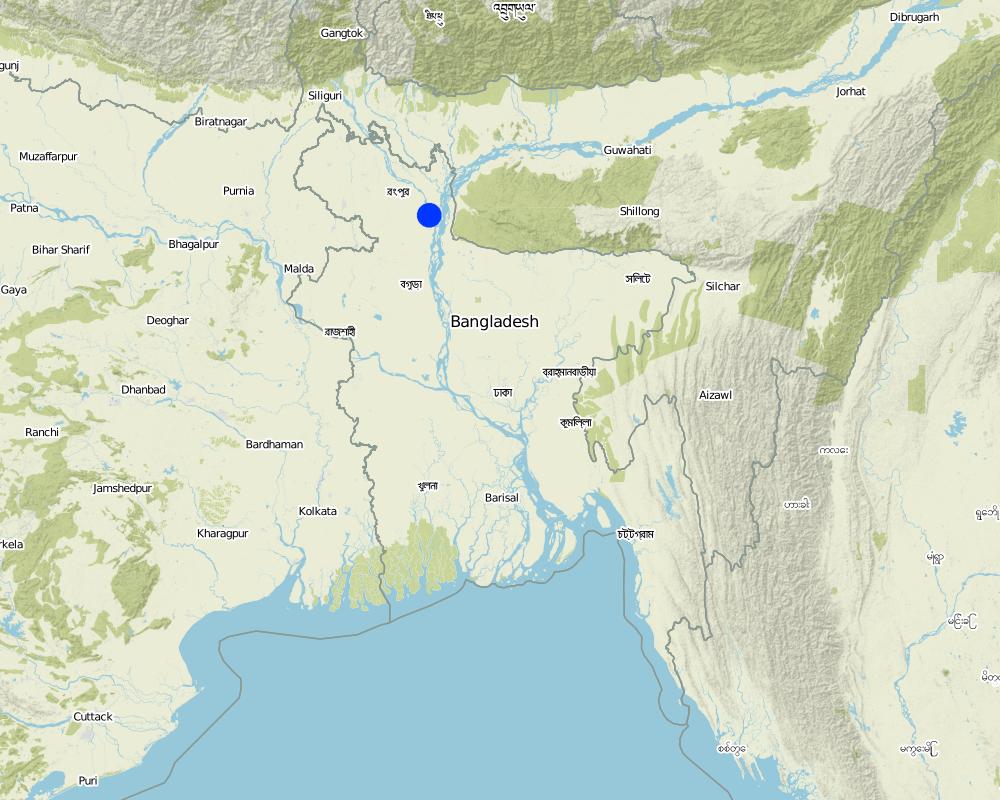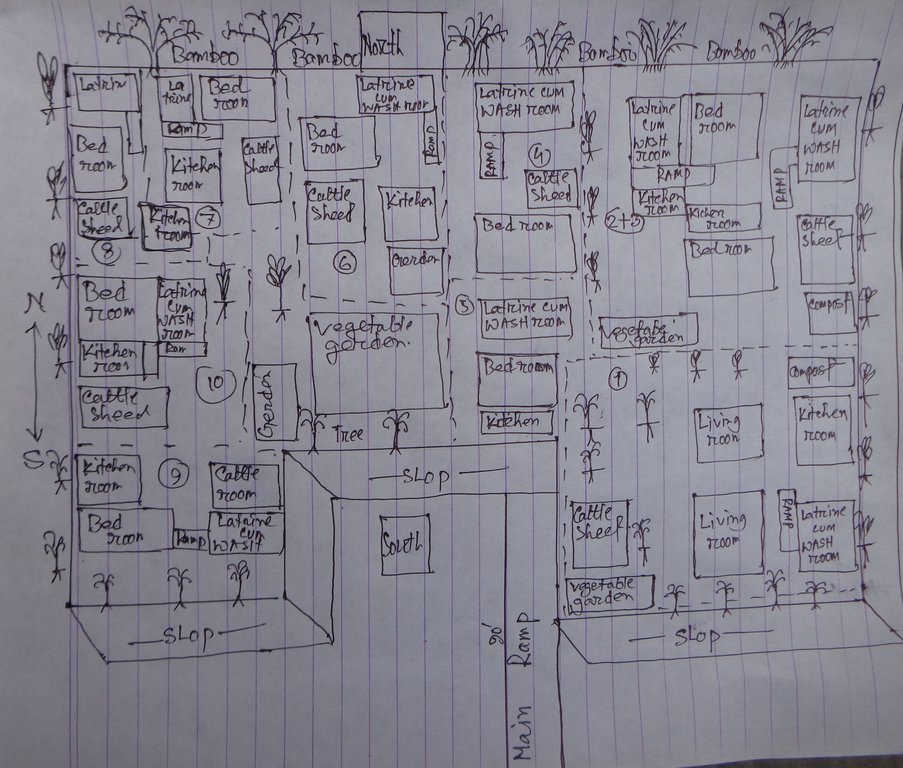Disability inclusive, flood resilient cluster village [Bangladesh]
- Creation:
- Update:
- Compiler: Subir Saha
- Editors: Subir Saha, Manuel Rothe
- Reviewer: Alexandra Gavilano
"Protibandhita Bandhob Bonna Sohisnu Gucca Gram"
technologies_2005 - Bangladesh
View sections
Expand all Collapse all1. General information
1.2 Contact details of resource persons and institutions involved in the assessment and documentation of the Technology
Name of project which facilitated the documentation/ evaluation of the Technology (if relevant)
Book project: where people and their land are safer - A Compendium of Good Practices in Disaster Risk Reduction (DRR) (where people and their land are safer)Name of the institution(s) which facilitated the documentation/ evaluation of the Technology (if relevant)
Christoffel Blindenmission (CBM) - Switzerland1.3 Conditions regarding the use of data documented through WOCAT
When were the data compiled (in the field)?
09/11/2016
The compiler and key resource person(s) accept the conditions regarding the use of data documented through WOCAT:
Yes
1.4 Declaration on sustainability of the described Technology
Is the Technology described here problematic with regard to land degradation, so that it cannot be declared a sustainable land management technology?
No
Comments:
Not problematic with regard land degradation. It provides efficient and sustainable use of available land resources.
1.5 Reference to Questionnaire(s) on SLM Approaches
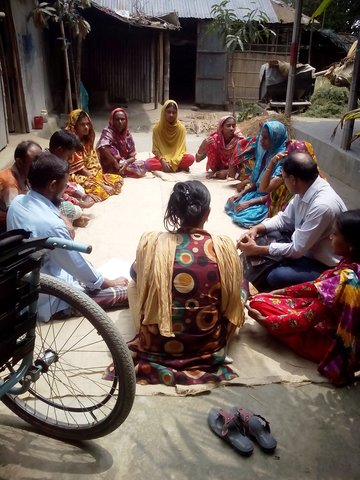
Disability inclusive Disaster Risk Reduction [Bangladesh]
The disability inclusive approach is centered around the meaningful contribution and leadership of persons with disabilties during the entire project management cycle, from the planning stage to the evaluation of the impact of a project. It contributes to empowering them to overcome social exclusion and recognizes their needs and priorities …
- Compiler: Subir Saha
2. Description of the SLM Technology
2.1 Short description of the Technology
Definition of the Technology:
The inclusive, flood-resilient cluster village provides safe housing, food security and income generation for multiple families, including persons with disabilities, in a highly flood prone area of Gaibandha District in northern Bangladesh. The land was raised above flood level and is protected by deep rooted fruit trees to prevent soil erosion and provide income for the land users.
2.2 Detailed description of the Technology
Description:
The inclusive, flood-resilient cluster village was introduced in a rural area with a high risk of recurring monsoon floods. The purpose of the technology is to provide safe housing, safe shelter for livestock, food security and income generation for ten families, including persons with disabilities.
The main components of the technology are:
1) The raising of a piece of land by seven feet (213cm), to three feet (91cm) above expected highest flood levels. Solid soil was banked up to encircle a 30'000 square feet (roughly 50x57m) piece of land and then the space within was filled up with sand collected from a nearby river bank. A one-foot layer of solid soil was added to cover the entire area.
2) The protection of the raised land from soil erosion during floods by planting a combination of deep-rooted fruit- and medicine trees around the border of the raised land. The trees include a number of different types of deep-rooted and light-rooted fruit trees and one type of medicine tree, Azadirachta Indica, locally known as "Neem". In addition, the slope of the border area was covered by grass turf to protect the soil from being washed out by rain. Two types of deep-rooted and flood resistant grasses were used. A drainage system was installed to facilitate water runoff.
3) The planting of a 150 square feet (14m2) commonly used homestead vegetable garden at the center of the cluster village. The cultivated vegetables include red spinach, jute leaf, basella leaf, spinach, radish, cabbage, okra, bottle-guts, cucumber and beans, allowing for a summer and a winter harvest. Together with the fruit trees, the vegetable garden provides food security during prolonged flooding. They also provide improved nutrition and income generating opportunities through selling of a part of the harvest in the market.
4) Making the village accessible for persons with disabilities through different accessibility measures, including the construction of a ramp, connecting the cluster village entrance with the road, and of accessible common Water-, Sanitation- and Hygiene (WASH) facilities, including a latrine, deep bore hole water source and water storage tank.
5) Installation of a solar panel to ensure uninterrupted, flood-resilient power supply. The level of power supply is sufficient to ensure coverage of electricity needs during flood season, when regular supply is around 15% below annual average.
The Cluster village was constructed as part of a disaster risk reduction project by CDD (Center for Disability in Development) from Bangladesh, with the support of CBM (Christoffel Blindenmission), an international development organization and funded by a donor from Germany. The main cost for inputs were provided to the land users by the project, including rent of construction machinery, paid labor, soil and construction material for the ramp and WASH facilities. The land users contributed labor and seedlings for the planning of the border trees and the homestead vegetable garden.
The main benefits of the technology from the perspective of land users are the protection it provides for houses and livestock, which would otherwise be in danger of loss during floods. The availability of food, water and electricity allows land users to remain in their homes during floods and avoid evacuation and the risk associated with it, including for example protection risks or the risk of theft. The flood protected vegetable gardens and fruit trees provide a year-round, sustainable source of food and income, providing food security and improved nutrition. The Neem tree provides medical and hygiene uses of the branches and leaves.
The cluster village is used as a safe space for the land users and other members of the community and their livestock during floods. Land users who are persons with disabilities or elderly benefit from the accessible infrastructure. With multiple families sharing land, the cluster villages provides optimal utilization of land resources. An additional benefit mentioned by land users is that the joint use by multiple families led to a more progressive social culture.
2.3 Photos of the Technology
2.4 Videos of the Technology
2.5 Country/ region/ locations where the Technology has been applied and which are covered by this assessment
Country:
Bangladesh
Region/ State/ Province:
Gaibandha District
Further specification of location:
Horipur Union, Sundargonj Sub district,
Comments:
Kani Charitabari, Horipur Union, Sundargonj sub district, Gaibandha District.
Map
×2.6 Date of implementation
Indicate year of implementation:
2016
2.7 Introduction of the Technology
Specify how the Technology was introduced:
- through projects/ external interventions
Comments (type of project, etc.):
The technology was introduced as part of a disaster risk reduction project, implemented the Center for Disability in Development (CDD) with the support of Christoffel Blindemission (CBM) and with participation and leadership of the local community. The project was financially supported a group of donors from Germany.
3. Classification of the SLM Technology
3.1 Main purpose(s) of the Technology
- reduce risk of disasters
- adapt to climate change/ extremes and its impacts
- create beneficial economic impact
- create beneficial social impact
3.2 Current land use type(s) where the Technology is applied

Settlements, infrastructure
- Settlements, buildings
3.3 Further information about land use
Water supply for the land on which the Technology is applied:
- mixed rainfed-irrigated
Number of growing seasons per year:
- 2
Specify:
Summer and winter
Livestock density (if relevant):
Livestock are available in every household.
3.4 SLM group to which the Technology belongs
- improved ground/ vegetation cover
- cross-slope measure
- home gardens
3.5 Spread of the Technology
Specify the spread of the Technology:
- applied at specific points/ concentrated on a small area
3.6 SLM measures comprising the Technology

vegetative measures
- V1: Tree and shrub cover
- V2: Grasses and perennial herbaceous plants

structural measures
- S7: Water harvesting/ supply/ irrigation equipment
- S8: Sanitation/ waste water structures
- S9: Shelters for plants and animals
- S10: Energy saving measures

management measures
- M1: Change of land use type
- M2: Change of management/ intensity level
- M6: Waste management (recycling, re-use or reduce)
3.7 Main types of land degradation addressed by the Technology

soil erosion by water
- Wt: loss of topsoil/ surface erosion
- Wr: riverbank erosion
3.8 Prevention, reduction, or restoration of land degradation
Specify the goal of the Technology with regard to land degradation:
- prevent land degradation
- reduce land degradation
4. Technical specifications, implementation activities, inputs, and costs
4.1 Technical drawing of the Technology
4.2 Technical specifications/ explanations of technical drawing
The drawing shows the layout of the disability inclusive, flood resilient Cluster village. The components of the technology are:
Raised land/plinth: 1) Purchase of land of a total area of 18'000 square feet (ca. 40x40m). Land ownership transferred to joint ownership of 10 families. 2) Collect 15'000 cubic feet (425m3) of solid soil from different pieces of land in the community. The soil was donated by members of the community, who were either related to the land users of the cluster village or donated in support of the construction of a safe space which can be used by the community during floods. 3) Banking up of 3 feet (91cm) of solid soil along the borders of the land. 4) Filling of area with 140'000 cubic feet (3965m3) of sand, extracted from a nearby riverbank with a rented sand extraction machine, raising the land to 6 feet (183cm). 5) Covering the entire area with one additional foot of solid soil, rasing the land to 7 feet (213cm), which means 3 feet (91cm) above the maximum expected flood levels.
Soil protected through deep-rooted trees: 1) Planting of deep-rooted and light-rooted fruit trees, surrounding the entire border of the raised land. The trees include deep rooted fruit trees like mango, black berry, jack-fruit, guava, coconut and areca nut, light-rooted fruit trees like banana and Papaya, a deep-rooted medicine tree, locally called "Neem" and the light-rooted Dhol Kalmi tree (pink morning glory). The number of deep-rooted threes was 100, with a spacing of around 5 feet in between each. They were planted to cover the entire perimeter of the raised land. In between the deep-rooted trees, 60 light-rooted trees were planted. In front of the deep-rooted trees, 60 bamboo bushes were planted to provide additional protection from wind and rain. 2) Turfing of the entire slope surrounding the cluster village with two flood resistant grasses: Durva (Cynodon dactylon) and Catkin grass. 3) Installation of a central drainage system with 15 plastic pipes ensuring water runoff from the wastewater pond.
Road access through ramp: The connecting ramp of the cluster village is 90 feet length, 6 feet width. There are five landing point of this ramp with smooth slopping. The construction material includes class one brick, brick stone, cement, sand, polythene and red oxide color for color contrast, which is appropriate for low vision and visually impaired persons. There is a 5 inch border on both sides of the ramp for safe movement of a wheel chair user.
Accessible household water and sanitation facilities: Latrine and wash-room are constructed for every house in the cluster village, following universal design standards. Latrines are connected to the wash room and the main house through ramps. There is a railing on both sides of the latrine and the entrance is wider for access of a wheel chair users. Water system for the latrine and wash room is provided from a water tank on three pillars behind the latrine, which is also connected to the main house for provision of drinking water. The tank is filled by hand pump ('magic pump') which functions with minimal hand pressure. The WASH facilities are accessible and usable by everyone including persons with disabilities, pregnant women or aged persons.
Home vegetable gardens: Every household has an individual homestead vegetable gardens where land users cultivate seasonal vegetables year-round. Gardens vary in size between averaging about 1.5 decimal (60m2) in size and are surrounded by bamboo fencing. The land owners are using organic fertilizer/compost for the vegetable production of their choice. By using cow's manure and wastage they are producing the compost in the behind of their houses in a ditch.
Solar system: A mini solar system is installed on the roof for each house by using a small panel with a 12-volt battery . Each system has the capacity of providing power for light for 8 hours. An introduction to system maintenance was given to the land users by the provider of the solar system.
4.3 General information regarding the calculation of inputs and costs
Specify how costs and inputs were calculated:
- per Technology unit
Specify unit:
Cluster village
Specify volume, length, etc. (if relevant):
18'000 square feet piece of land
other/ national currency (specify):
Bangladeshi Taka
Indicate exchange rate from USD to local currency (if relevant): 1 USD =:
80.0
Indicate average wage cost of hired labour per day:
300
4.4 Establishment activities
| Activity | Type of measure | Timing | |
|---|---|---|---|
| 1. | Selecting the place for cluster village construction | Management | During rainy season in 2015 |
| 2. | Establish collaboration with 10 families who will become land users | Management | December 2015 |
| 3. | Land Raising & Ramp construction | Structural | December 2015 to March 2016 |
| 4. | Reconstruction the existing houses of the land users on the raised land | Structural | April 2016, before onset of rainy season 2016 |
| 5. | Planting of deep- and light-rooted fruits trees, bamboo bushes and grass turfing along the boundery | Agronomic | February 2016 to March 2016 |
| 6. | Install accessible water & sanitation system | Structural | April-June 2016 |
| 7. | Establish home garden in front of each house | Vegetative | June-July 2016 |
| 8. | Install mini solar system for each house | Other measures | Aug-sep 2016 |
| 9. | Prepare livestock shed for each house | Structural | October 2016 |
4.5 Costs and inputs needed for establishment
If possible, break down the costs of establishment according to the following table, specifying inputs and costs per input. If you are unable to break down the costs, give an estimation of the total costs of establishing the Technology:
1777380.0
| Specify input | Unit | Quantity | Costs per Unit | Total costs per input | % of costs borne by land users | |
|---|---|---|---|---|---|---|
| Labour | Land raising, tree planting and turfing on slope | person days | 290.0 | 300.0 | 87000.0 | 10.0 |
| Labour | Ramp construction | person days | 115.0 | 350.0 | 40250.0 | 10.0 |
| Labour | House reconstruction and WASH facilities | person days | 200.0 | 400.0 | 80000.0 | 10.0 |
| Labour | Solar system installation | person days | 10.0 | 300.0 | 3000.0 | 10.0 |
| Equipment | WASH equipment (latrine, magic pump, water tank, pipes, switch, pillars and other) | pieces | 10.0 | 46658.0 | 466580.0 | |
| Equipment | Solar system | pieces | 10.0 | 6300.0 | 63000.0 | |
| Plant material | Deep rooted trees | pieces | 100.0 | 40.0 | 4000.0 | 100.0 |
| Plant material | Seed for vegetable | KG | 5.0 | 1000.0 | 5000.0 | 100.0 |
| Plant material | Sapling purchase | pieces | 100.0 | 50.0 | 5000.0 | 100.0 |
| Plant material | Light rooted tree | pieces | 60.0 | 30.0 | 1800.0 | |
| Fertilizers and biocides | Organic fertilizer (compost) | KG | 600.0 | 10.0 | 6000.0 | 100.0 |
| Construction material | Rent for shallow machine for sand extraction | Daily rent | 10.0 | 28800.0 | 288000.0 | |
| Construction material | Grass turfing | square feet | 15000.0 | 10.0 | 150000.0 | |
| Construction material | Allowance for house reconstruction material | House | 10.0 | 2000.0 | 20000.0 | |
| Construction material | Ramp construction | Piece | 1.0 | 125750.0 | 125750.0 | |
| Other | Project management (monitoring and support) | persons-days | 180.0 | 2400.0 | 432000.0 | |
| Total costs for establishment of the Technology | 1777380.0 | |||||
If land user bore less than 100% of costs, indicate who covered the remaining costs:
The project, human resource supported by CBM, CDD and a funded by private donor.
Comments:
Labor for tree plantation, home stead gardening & house reconstruction was contributed by the land users.
4.6 Maintenance/ recurrent activities
| Activity | Type of measure | Timing/ frequency | |
|---|---|---|---|
| 1. | Turfing: Repair leakages, replace grass etc. | Structural | before onset of rains |
| 2. | Tree maintenance: Cutting branches, manure of roots etc. | Agronomic | Rainy season |
| 3. | Vegetable gardening | Vegetative | Summer & Winter season |
| 4. | Housing repairs | Structural | After harvesting season/ once in a year |
| 5. | Water and Sanitation system servicing and repairs | Management | After harvesting season/once in a year |
| 6. | Solar system maintenance | Management | Winter season/once in ayear |
| 7. | Village group meeting for decision making and conflict resolution | Management | Once in a month |
| 8. | Organic composting/fertilizer production | Other measures | Continuous |
4.7 Costs and inputs needed for maintenance/ recurrent activities (per year)
If possible, break down the costs of maintenance according to the following table, specifying inputs and costs per input. If you are unable to break down the costs, give an estimation of the total costs of maintaining the Technology:
85000.0
| Specify input | Unit | Quantity | Costs per Unit | Total costs per input | % of costs borne by land users | |
|---|---|---|---|---|---|---|
| Labour | House repairs | person days | 10.0 | 300.0 | 3000.0 | 100.0 |
| Labour | Ramp repairs | person days | 10.0 | 300.0 | 3000.0 | 100.0 |
| Labour | Plingth raising and plantation | person days | 30.0 | 300.0 | 9000.0 | 100.0 |
| Labour | Solar system servicing by technical experts | piece | 10.0 | 500.0 | 5000.0 | 100.0 |
| Plant material | Seed for vegetable gardening | KG | 5.0 | 1000.0 | 5000.0 | |
| Construction material | Soil for slope maintenance | square feet | 5000.0 | 10.0 | 50000.0 | |
| Construction material | Sand for slope maintenance | KG | 5000.0 | 2.0 | 10000.0 | |
| Total costs for maintenance of the Technology | 85000.0 | |||||
Comments:
Land users are agreed to contribute 100% maintenance cost
4.8 Most important factors affecting the costs
Describe the most determinate factors affecting the costs:
Market fluctuation and scarcity of goods in the flood season.
5. Natural and human environment
5.1 Climate
Annual rainfall
- < 250 mm
- 251-500 mm
- 501-750 mm
- 751-1,000 mm
- 1,001-1,500 mm
- 1,501-2,000 mm
- 2,001-3,000 mm
- 3,001-4,000 mm
- > 4,000 mm
Specifications/ comments on rainfall:
Heavy rainfalls are one of the causes for flooding
Agro-climatic zone
- humid
5.2 Topography
Slopes on average:
- flat (0-2%)
- gentle (3-5%)
- moderate (6-10%)
- rolling (11-15%)
- hilly (16-30%)
- steep (31-60%)
- very steep (>60%)
Landforms:
- plateau/plains
- ridges
- mountain slopes
- hill slopes
- footslopes
- valley floors
Altitudinal zone:
- 0-100 m a.s.l.
- 101-500 m a.s.l.
- 501-1,000 m a.s.l.
- 1,001-1,500 m a.s.l.
- 1,501-2,000 m a.s.l.
- 2,001-2,500 m a.s.l.
- 2,501-3,000 m a.s.l.
- 3,001-4,000 m a.s.l.
- > 4,000 m a.s.l.
Indicate if the Technology is specifically applied in:
- not relevant
5.3 Soils
Soil depth on average:
- very shallow (0-20 cm)
- shallow (21-50 cm)
- moderately deep (51-80 cm)
- deep (81-120 cm)
- very deep (> 120 cm)
Soil texture (> 20 cm below surface):
- coarse/ light (sandy)
Topsoil organic matter:
- high (>3%)
5.4 Water availability and quality
Ground water table:
> 50 m
Availability of surface water:
medium
Water quality (untreated):
good drinking water
Is water salinity a problem?
No
Is flooding of the area occurring?
Yes
Regularity:
frequently
5.5 Biodiversity
Species diversity:
- low
Habitat diversity:
- low
5.6 Characteristics of land users applying the Technology
Sedentary or nomadic:
- Sedentary
Market orientation of production system:
- mixed (subsistence/ commercial
Off-farm income:
- > 50% of all income
Relative level of wealth:
- poor
Individuals or groups:
- individual/ household
- groups/ community
Level of mechanization:
- manual work
- animal traction
Gender:
- women
- men
Age of land users:
- youth
- middle-aged
Indicate other relevant characteristics of the land users:
Age of land users includes children, youth, middle-aged as well as elderly.
5.7 Average area of land owned or leased by land users applying the Technology
- < 0.5 ha
- 0.5-1 ha
- 1-2 ha
- 2-5 ha
- 5-15 ha
- 15-50 ha
- 50-100 ha
- 100-500 ha
- 500-1,000 ha
- 1,000-10,000 ha
- > 10,000 ha
Is this considered small-, medium- or large-scale (referring to local context)?
- small-scale
Comments:
Land users jointly own the land of the cluster village. They do not own any additional agricultural land and work as daily laborers and sharecropers.
5.8 Land ownership, land use rights, and water use rights
Land ownership:
- group
Land use rights:
- individual
Water use rights:
- individual
Comments:
Land users own the land of the cluster village jointly, including a proportional share of land- and water use rights.
5.9 Access to services and infrastructure
health:
- poor
- moderate
- good
education:
- poor
- moderate
- good
technical assistance:
- poor
- moderate
- good
employment (e.g. off-farm):
- poor
- moderate
- good
markets:
- poor
- moderate
- good
energy:
- poor
- moderate
- good
roads and transport:
- poor
- moderate
- good
drinking water and sanitation:
- poor
- moderate
- good
financial services:
- poor
- moderate
- good
6. Impacts and concluding statements
6.1 On-site impacts the Technology has shown
Socio-economic impacts
Production
crop production
Comments/ specify:
Fruit and vegetable production increased after introduction of the cluster village. Because of decreased loss of home and property during floods, labor is freed for crop production which increased overall crop production in the wider area.
crop quality
Comments/ specify:
Fruit and vegetable quality is improved because of availability of Irrigation.
animal production
Comments/ specify:
Livestock mortality rate is reduced because of safe space in Cluster village.
risk of production failure
Comments/ specify:
Homestead vegetable garden and fruit tree plantation above flood level has a significantly reduced risk of production failure.
product diversity
Comments/ specify:
The flood-protected homestead vegetable garden allows for higher product diversity.
production area
Comments/ specify:
Increased availabilty of flood protected land for vegetable gardening.
energy generation
Comments/ specify:
Energy supply was not available before installation of solar panel.
Water availability and quality
drinking water availability
Comments/ specify:
Installation of deep tube well water source.
drinking water quality
Comments/ specify:
Significantly higher water quality during flood, because of flood protected water source in cluster village.
water availability for livestock
Comments/ specify:
Installation of deep tube well water source.
water quality for livestock
Comments/ specify:
Significantly higher water quality during flood, because of flood protected water source in cluster village.
irrigation water availability
Comments/ specify:
Irrigation available to land users after installation of deep tube well.
demand for irrigation water
Comments/ specify:
Demand for irrigation water increased because of vegetable garden.
Income and costs
farm income
Comments/ specify:
Increase of farm income through selling of fruit and vegetables.
diversity of income sources
Comments/ specify:
Additional income source through selling of fruit and vegetables.
economic disparities
Comments/ specify:
Decreased income disparities between the land users of the cluster village due to fruit and vegetable production available to all land users, Decrease income disparities between land users of the cluster village and other members of the communty because of the reduction of loss from flood damage.
workload
Comments/ specify:
Somewhat increased workload for maintenance of technology but decreased because of avoidance of damaged from floods.
Socio-cultural impacts
food security/ self-sufficiency
Comments/ specify:
Increased food security through flood prodected homestead garden and tree plantation.
health situation
Comments/ specify:
Higher attendance of health workers because the cluster village offer suitable group meeting rooms and accomodation. Cluster village was constructed in vicinity of community clinic. Better hygiene through WASH facilities.
cultural opportunities
Comments/ specify:
The cluster village is a suitable meeting point for the entire community, for social gatherings or festivals.
recreational opportunities
Comments/ specify:
Cluster village offers common space for children and other land users for Joint recreational activities.
situation of socially and economically disadvantaged groups
Comments/ specify:
Much improved situation for persons with disabiltiies who are part of the land users. All persons with disabiltiies in the wider community use the cluster village as a safe space during floods. Improved situation for all land users who are from marginalized parts of society (daily laborers and share croppers).
Ecological impacts
Soil
soil loss
Comments/ specify:
Soil erosion during floods decreased because of deep- and light-rooted border tree plantation.
Climate and disaster risk reduction
flood impacts
Comments/ specify:
Raised land as safe space above flood level.
drought impacts
Comments/ specify:
Drought impact in summer season decreased because of Irrigation.
6.2 Off-site impacts the Technology has shown
available shelter and safe space
Comments/ specify:
Cluster village provides additional safe space/shelter for the wider community.
6.3 Exposure and sensitivity of the Technology to gradual climate change and climate-related extremes/ disasters (as perceived by land users)
Climate-related extremes (disasters)
Climatological disasters
| How does the Technology cope with it? | |
|---|---|
| drought | well |
Hydrological disasters
| How does the Technology cope with it? | |
|---|---|
| general (river) flood | very well |
6.4 Cost-benefit analysis
How do the benefits compare with the establishment costs (from land users’ perspective)?
Short-term returns:
positive
Long-term returns:
very positive
How do the benefits compare with the maintenance/ recurrent costs (from land users' perspective)?
Short-term returns:
slightly positive
Long-term returns:
very positive
6.5 Adoption of the Technology
- 10-50%
If available, quantify (no. of households and/ or area covered):
Around 10-15% of households which equals roughly 70 households.
Of all those who have adopted the Technology, how many have did so spontaneously, i.e. without receiving any material incentives/ payments?
- 0-10%
Comments:
The technology is replicated by households who receive assistance from local government for families at risk of flood damage.
6.6 Adaptation
Has the Technology been modified recently to adapt to changing conditions?
Yes
If yes, indicate to which changing conditions it was adapted:
- changing markets
Specify adaptation of the Technology (design, material/ species, etc.):
Peoples of cluster villages are selling vegetables and fruits in the local market and some of them are carrying the fruits in the distance market. They are becoming more interested to plant more fruit trees in the cluster village. If it is continue in future it would be a fruits and vegetable market in the cluster village. At the same time they started selling cows milk in the local market and its demand is increasing day to day.
6.7 Strengths/ advantages/ opportunities of the Technology
| Strengths/ advantages/ opportunities in the land user’s view |
|---|
| Ownership of the land user's are there. Its a community driven initiative & disability inclusive in all respect. They are happy to give shelter to the other villagers during flood season. There is an opportunity to create an example of a model village in this area. |
| Strengths/ advantages/ opportunities in the compiler’s or other key resource person’s view |
|---|
| Its an innovative program. Peoples participation and their contribution is the main asset. Universal accessibility of the cluster village communicating benefit to other villagers during rainy as well as flood season. This pilot program can be replicated to other riverine areas in Bangladesh. |
6.8 Weaknesses/ disadvantages/ risks of the Technology and ways of overcoming them
| Weaknesses/ disadvantages/ risks in the land user’s view | How can they be overcome? |
|---|---|
| The intensity of floods is difficult to predict. With average flood levels rising, land users still have to live with the risk of flood levels going beyond the level of their rised land. | More research on changing weather/climatic patterns and scientific measurement of expected flood levels. |
| Weaknesses/ disadvantages/ risks in the compiler’s or other key resource person’s view | How can they be overcome? |
|---|---|
| Government and Non government organizations extension services are not available in this area. Livelihood of the cluster village peoples depending on seasonal agriculture. | Income raising multiple activity need to be introduces. A small scale disability inclusive comprehensive project could be implemented here. |
7. References and links
7.1 Methods/ sources of information
- field visits, field surveys
7
- interviews with land users
10
- interviews with SLM specialists/ experts
1
- compilation from reports and other existing documentation
4
Links and modules
Expand all Collapse allLinks

Disability inclusive Disaster Risk Reduction [Bangladesh]
The disability inclusive approach is centered around the meaningful contribution and leadership of persons with disabilties during the entire project management cycle, from the planning stage to the evaluation of the impact of a project. It contributes to empowering them to overcome social exclusion and recognizes their needs and priorities …
- Compiler: Subir Saha
Modules
No modules


